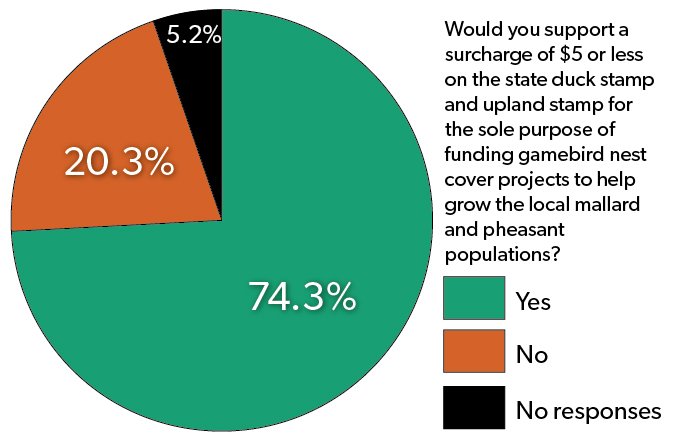
Apr 5, 2019
Survey: Hunters are willing to pay for breeding habitat
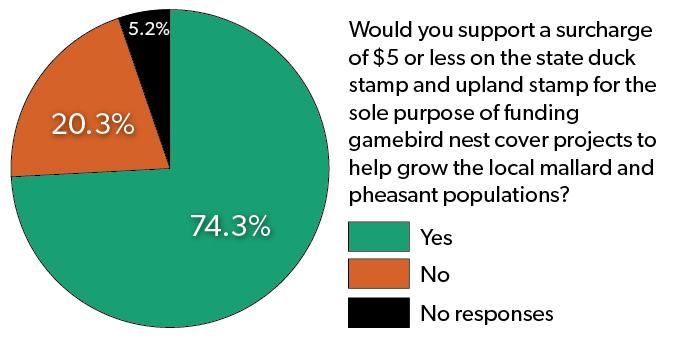 Nearly three out of four Golden State waterfowl hunters surveyed by California Waterfowl would be willing to pay a surcharge of up to $5 on their duck and upland hunting stamps to fund nest cover projects to help grow the local mallard and pheasant populations.
Nearly three out of four Golden State waterfowl hunters surveyed by California Waterfowl would be willing to pay a surcharge of up to $5 on their duck and upland hunting stamps to fund nest cover projects to help grow the local mallard and pheasant populations.
This was one of many findings of a survey of more than 1,500 CWA members and supporters last month about their 2018-19 waterfowl seasons and their preferences about regulations and public land hunt programs.
Hunters' willingness to tax themselves – a rarity in public policy – goes back more than 100 years and is a point of pride in the hunting community. Hunting license fees, surcharges and excise taxes on firearms and ammunition provide substantial support for habitat restoration and maintenance.
In California, breeding habitat for waterfowl and pheasants is in decline, and hunters see the results of that decline clearly during their hunting seasons. Proposition 3 on the November ballot would have helped fund the waterfowl and upland game bird nesting habitat incentive program created last year by AB 2697 (Gallagher), a CWA-sponsored bill in the California Legislature. However, the proposition failed, and California Waterfowl is actively seeking funding sources to combat the continued erosion of vital wildlife habitat.
"We're deeply gratified at hunters' continued willingness to pay for programs that benefit wildlife," said Mark Hennelly, CWA vice president for legislation and public policy. "The entire state benefits from hunters' contributions in the form of healthy ecosystems."
Additional survey results are detailed below:
DEMOGRAPHICS
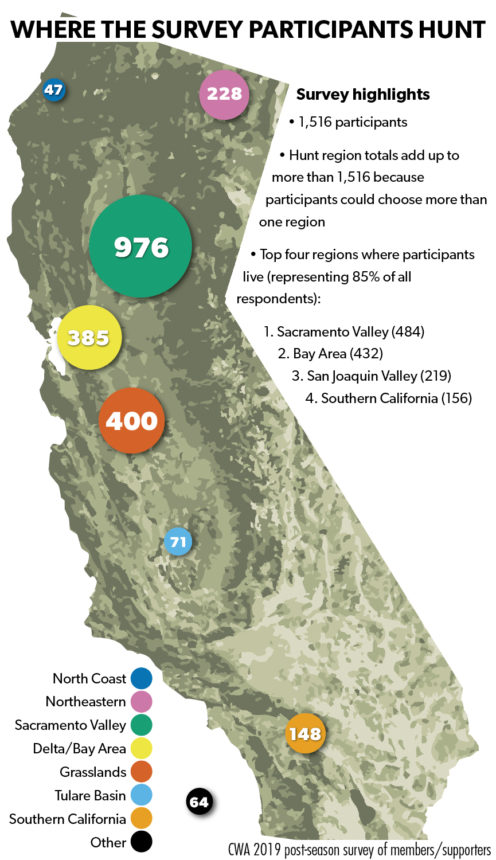 What region of the state do you live in?
What region of the state do you live in?
Sacramento Valley: 31.9%
Bay Area: 28.4%
San Joaquin Valley: 14.4%
Southern California: 10.2%
Other: 5.1%
Central Coast: 3.2%
North Coast: 2.7%
Northeastern California: 2.4%
No responses: 1.1%
What regions of the state do you hunt waterfowl in (check all that apply)?
Sacramento Valley: 65.5%
Grasslands: 26.8%
Delta/Bay Area (includes Suisun and Napa/Sonoma marshes): 25.8%
Northeastern California: 15.3%
Southern California: 9.9%
Tulare Basin: 4.7%
Other: 4.2%
North Coast (includes Humboldt Bay): 3.1%
HUNTING
Where did you hunt waterfowl during the 2018-19 season?
Exclusively on private land: 41.1%
A mix of public and private land: 33.2%
Exclusively on public land: 17.6%
If applicable, check all types of private land you hunted on:
Natural marsh club as guest/client: 34.6%
Leased rice blind, as leaseholder: 25.9%
Leased rice blind, as guest/client: 25.8%
Other (e.g., ranches) as guest/client: 22.9%
Natural marsh club as owner: 20.4%
Check all types of public land you hunted on in 2018-19:
Waterfowl refuges (state wildlife areas or national wildlife refuges): 50.4%
Public lakes, rivers and sloughs: 21.8%
Other public land: 9.7%
How many days did you hunt waterfowl in 2018-19?
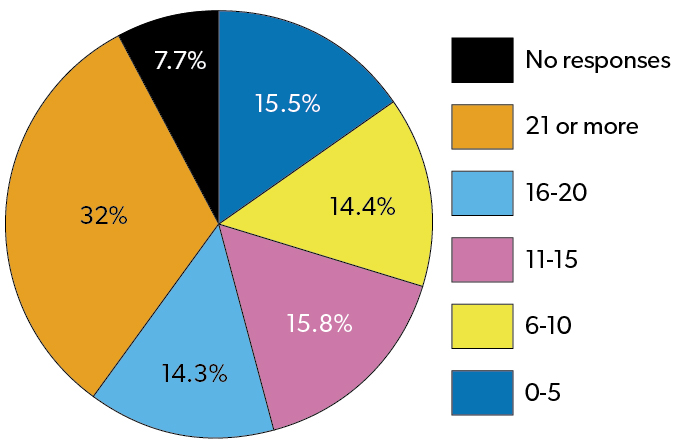
Was your 2018-19 waterfowl harvest higher or lower than the previous season?
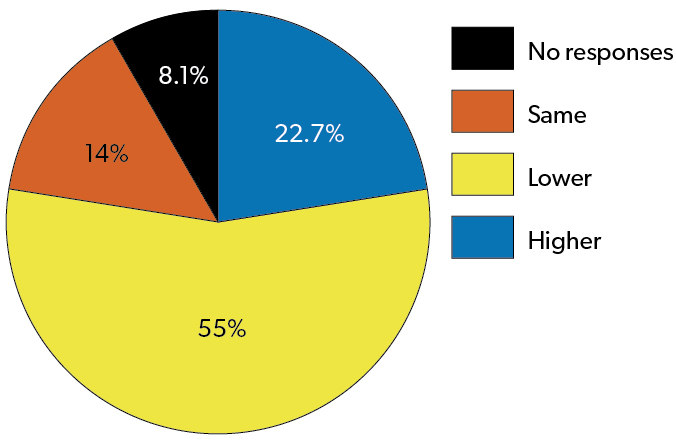
REGULATIONS AND HUNT PROGRAMS
Question: For the 2019-20 season, do you support extending the duck season for 5 more days until Friday, January 31 in the Balance of State, Southern San Joaquin and Southern California Zones? (The post-season youth hunt would also be moved back as needed (e.g. one week later) to help ensure a quality hunt for junior hunters.)
Yes: 1,289 (85%)
No: 152 (10%)
No responses: 75 (4.9%)
Question: If the season ending date was moved to January 31 in the Northeastern Zone, would you prefer a 10-day split (mid-season closure) in that zone so that hunting could still start in early October?
Yes: 814 (53.6%)
No: 557 (36.7%)
No responses: 145 (9.5%)
Question: Should the harvest strategy for pintail be modified to allow for a 3 or greater pintail bag limit in good pintail production years (under a liberal framework), recognizing that in poor pintail production years there may be an increased likelihood of 1 or 0 pintail bag limit?
Yes: 1,067 (70.3%)
No: 367 (24.2%)
No responses: 82 (5.4%)
Question: Would you support a three-pintail bag limit in exchange for a shorter pintail season?
Yes: 474 (31.2%)
No: 958 (63.1%)
No responses: 84 (5.5%)
Question: Would you support a surcharge of $5 or less on the state duck stamp and upland stamp for the sole purpose of funding gamebird nest cover projects to help grow the local mallard and pheasant populations?
Yes: 1,127 (74.3%)
No: 309 (20.3%)
No responses: 80 (5.2%)
Question: The Tule Lake NWR Spaced Blind/Sump B draw was changed to 4 p.m. the day before each hunt. Do you prefer the draw the afternoon before the hunt or the morning of the hunt?
The afternoon before the hunt: 704 (46.4%)
The morning of the hunt: 341 (22.4%)
No responses: 471 (31%)
Question: Currently, the Tule Lake and Lower Klamath NWRs open to afternoon hunting on the Wed. or Sat. after Dec. 15. Would you like to see that date moved up to Dec. 1?
Yes: 760 (50.1%)
No: 277 (18.2%)
No responses: 479 (31.5%)
Question: At Upper Butte Basin Wildlife Area (Howard Slough, Little Dry Creek and Llano Seco) should one person be able to enter the lottery on behalf of other members of his/her hunt party, similar to what is allowed at the Sacramento National Wildlife Refuge Complex?
Yes: 880 (58%)
No: 349 (23%)
No responses: 287 (18.9%)
Question: Should Howard Slough Wildlife Area be open for the post season youth hunt?
Yes: 1,149 (75.7%)
No: 86 (5.6%)
No responses: 281 (18.5%)
Question: Do you support opening the San Joaquin River National Wildlife Refuge for hunting?
Yes: 1,151 (75.9%)
No: 103 (6.7%)
No responses: 262 (17.2%)
Question: Should public area managers hold a public meeting during the waterfowl season or out of season to solicit input from hunters on the management of the areas?
In season: 345 (22.7%)
Out of season: 969 (63.9%)
No responses: 202 (13.3%)
Question: If you answered, "In season" and you would plan to attend, what timing would you prefer (check all that apply)?
Night before a hunt day: 175 (38.5%)
Other non-hunt day: 179 (39.4%)
Afternoon of a hunt day: 138 (30.3%)
Question: What do you think the recommended distance between parties should be in free roam areas?
100 yards: 145 (9.5%)
150 yards: 405 (26.7%)
200 yards: 688 (45.3%)
Other: 85 (5.6%)
No response:s 193 (12.7%)
Question: Has access to public hunt areas become better or worse in the last 5 years?
Better: 108 (7.1%)
Worse: 732 (48.2%)
Same: 390 (25.7%)
No responses: 286 (18.8%)
Question: What are the biggest challenges facing public hunters? (Ranked among 7 choices.)
1: Hunters setting up too close in free roam areas
2: Limited access to optimal habitat areas that are attractive to ducks
3: Enforcement of refuge rules / bad hunter behavior
4: Water/ habitat management on refuges
5: Too much sanctuary vs. available hunt acres on refuges
6: No refill opportunities in productive waterfowl areas
7: Significant quota restrictions on refuges


